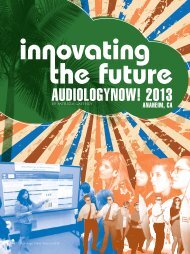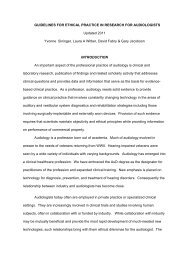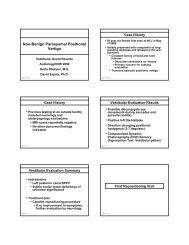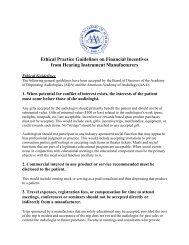Noise-Induced Hearing Loss - American Academy of Audiology
Noise-Induced Hearing Loss - American Academy of Audiology
Noise-Induced Hearing Loss - American Academy of Audiology
Create successful ePaper yourself
Turn your PDF publications into a flip-book with our unique Google optimized e-Paper software.
Assessing <strong>Hearing</strong> Protectors in the<br />
Clinic- How to Perform CPT 92596<br />
NRR (dB)<br />
Real-Ear Attenuation (dB)<br />
Using the NRR<br />
Not Really Right<br />
dBA P =dBA w – ½ (NRR – 7)<br />
workplace noise<br />
protected employee exposure<br />
• 50% derating: a safety margin to account for the field vs.<br />
lab difference in the labeled NRR.<br />
• 7-dB correction: another safety margin to account for the<br />
spectral uncertainty (i.e., the difference between the C<br />
and A weighted levels).<br />
35<br />
30<br />
25<br />
20<br />
15<br />
10<br />
5<br />
0<br />
-10<br />
0<br />
10<br />
20<br />
30<br />
40<br />
Predicted vs. Field Values<br />
V-51R<br />
EP-100<br />
Field<br />
S<strong>of</strong>t<br />
Custom<br />
Method B<br />
SoundBan<br />
Com-Fit<br />
UltraFit<br />
Mark IV<br />
H7P3E<br />
Classic<br />
H9A<br />
UF-1<br />
Classic+UF-1<br />
Attenuation Data<br />
Tom Thunder, AuD, INCE ( tthunder@comcast.net)<br />
Label Test<br />
50<br />
.125 .250 .500 1.0 2.0 4.0 8.0<br />
Frequency (kHz)<br />
0<br />
15 Std. Dev.<br />
ANSI S12.6 -1997 (R2002)<br />
REAT<br />
(Real-Ear at Threshold)<br />
ANSI S12.6 – 1997<br />
(R2002)<br />
Sound-field thresholds<br />
measured without HPD<br />
Sound-field thresholds<br />
measured with HPD<br />
The difference is the<br />
attenuation <strong>of</strong> the HPD<br />
(insertion loss)<br />
<strong>American</strong> <strong>Academy</strong> <strong>of</strong><br />
<strong>Audiology</strong> (April 2009)<br />
Method A:<br />
- Fit by tester<br />
- 10 experienced subjects<br />
- 3 trials (30 runs)<br />
Method B:<br />
- Fit by subject<br />
- 20 naïve subjects<br />
- 2 trials (40 runs)<br />
Laboratory Testing <strong>of</strong> HPDs<br />
Reverberant Room<br />
1/3<br />
1/3-Octaveband <strong>Noise</strong> Signal<br />
Best Practice Bulletin:<br />
<strong>Hearing</strong> Protection-Emerging Trends: Individual Fit Testing<br />
Any population-based statistical estimate <strong>of</strong> hearing<br />
protector performance is a poor estimate <strong>of</strong> individual<br />
performance.<br />
If the purpose <strong>of</strong> HPD evaluation is to determine how well<br />
specific HPDs work on specific people, then they must be<br />
tested on individual people (similar to the quantitative fit<br />
testing <strong>of</strong> respirators).<br />
http://www.hearingconservation.org/docs/AllianceRecommendationForFitTesting_Final.pdf



